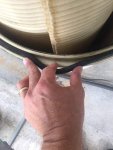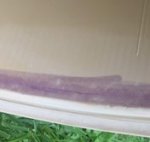Questions:
1. How long should a DE filter installed outdoors be expected to last?
2. Why would a rubber O-ring stretch over time?
Background:
I live in the Houston area, and have a Pentair NFS Plus 60 DE filter which is 11 years old, operating 10 hours per day year-round. It's on an equipment slab which has been covered for the last 8 years, but it does get indirect sunlight.
When checking on my chlorinator over the weekend (see that issue here), I discovered a slow leak from the area of the filter band clamp, which was dripping about 1 drop every 3-4 seconds. I shut down the pump and tightened the brass nut, but that made the leak worse. I normally disassemble and clean the filter grids once or twice a year, but had not done any maintenance on it recently. I took the filter back out of service and took it apart. I found the O-ring to be intact but it had a very sloppy fit. It is the original O-ring, and I typically lubricate it with pool lube every time I do the grid cleaning. I checked, and that procedure is consistent with the TFP tutorial on DE filter maintenance. I know in automotive applications, some types of rubber are to be avoided because they swell when exposed to materials like oil and gasoline. I'd never heard of that with respect to the greases used for pools, but I'm really scratching my head as to why this thing has such a poor fit.
Here is what it looked like with the O-ring seated in the channel all the way around but without any tension on it (i.e. I'm not stretching it, just gathering the "extra"):

My assumption was that this was the reason for my leak, so I purchased a replacement at the pool supply store and installed it today. It sat in the channel with a proper fit, however I had the same drip rate with it when I started up the pump. I disassembled the filter again, and upon closer inspection discovered a crack in the upper half that extends 10-12" around the circumference. It's in the location where the leak appeared to originate, but was behind the band clamp and not immediately obvious as the source of the leak. I used some PVC primer as a dye penetrant to see exactly how much of a crack it was. My assumption is this is a result of weathering and cycling loading on the filter body, but is there any chance that I caused the crack by over-tightening the band clamp at some point in the past (not this weekend - that was after the leak started)?

The extent of the crack on the interior surface isn't as long, so it appears to have originated from the exterior. These last two pictures are tiny because I have to stay under the TFP quota...

I realize I need a new filter cover, because the crack is likely to continue propagating and could eventually leak much worse. To get me by while I look for a replacement, I'm going to try an experiment. I've glued a piece of PVC shower pan liner to the interior surface and am letting it cure for 24 hours then try it and see if it holds. Based on some other posts I've read, it sounds like some folks have used fiberglass repair kits (since the filter body is fiberglass), others just say "replace it"... I've gotten 11 years out of this one, so I'm not sweating the fact that it needs to be replaced... just wondered if this is premature or something that is to be expected.

In the meantime, I'm just circulating the pool without filtration. Would appreciate thoughts on whether I should just replace the top or replace the entire unit. I can see some stress cracks in the filter grid manifold, and I assume the bottom half of the filter body might be subject to the same deterioration that caused the cracking on the top.
If you got to the bottom of this long-winded post, thanks!
1. How long should a DE filter installed outdoors be expected to last?
2. Why would a rubber O-ring stretch over time?
Background:
I live in the Houston area, and have a Pentair NFS Plus 60 DE filter which is 11 years old, operating 10 hours per day year-round. It's on an equipment slab which has been covered for the last 8 years, but it does get indirect sunlight.
When checking on my chlorinator over the weekend (see that issue here), I discovered a slow leak from the area of the filter band clamp, which was dripping about 1 drop every 3-4 seconds. I shut down the pump and tightened the brass nut, but that made the leak worse. I normally disassemble and clean the filter grids once or twice a year, but had not done any maintenance on it recently. I took the filter back out of service and took it apart. I found the O-ring to be intact but it had a very sloppy fit. It is the original O-ring, and I typically lubricate it with pool lube every time I do the grid cleaning. I checked, and that procedure is consistent with the TFP tutorial on DE filter maintenance. I know in automotive applications, some types of rubber are to be avoided because they swell when exposed to materials like oil and gasoline. I'd never heard of that with respect to the greases used for pools, but I'm really scratching my head as to why this thing has such a poor fit.
Here is what it looked like with the O-ring seated in the channel all the way around but without any tension on it (i.e. I'm not stretching it, just gathering the "extra"):

My assumption was that this was the reason for my leak, so I purchased a replacement at the pool supply store and installed it today. It sat in the channel with a proper fit, however I had the same drip rate with it when I started up the pump. I disassembled the filter again, and upon closer inspection discovered a crack in the upper half that extends 10-12" around the circumference. It's in the location where the leak appeared to originate, but was behind the band clamp and not immediately obvious as the source of the leak. I used some PVC primer as a dye penetrant to see exactly how much of a crack it was. My assumption is this is a result of weathering and cycling loading on the filter body, but is there any chance that I caused the crack by over-tightening the band clamp at some point in the past (not this weekend - that was after the leak started)?

The extent of the crack on the interior surface isn't as long, so it appears to have originated from the exterior. These last two pictures are tiny because I have to stay under the TFP quota...

I realize I need a new filter cover, because the crack is likely to continue propagating and could eventually leak much worse. To get me by while I look for a replacement, I'm going to try an experiment. I've glued a piece of PVC shower pan liner to the interior surface and am letting it cure for 24 hours then try it and see if it holds. Based on some other posts I've read, it sounds like some folks have used fiberglass repair kits (since the filter body is fiberglass), others just say "replace it"... I've gotten 11 years out of this one, so I'm not sweating the fact that it needs to be replaced... just wondered if this is premature or something that is to be expected.

In the meantime, I'm just circulating the pool without filtration. Would appreciate thoughts on whether I should just replace the top or replace the entire unit. I can see some stress cracks in the filter grid manifold, and I assume the bottom half of the filter body might be subject to the same deterioration that caused the cracking on the top.
If you got to the bottom of this long-winded post, thanks!

